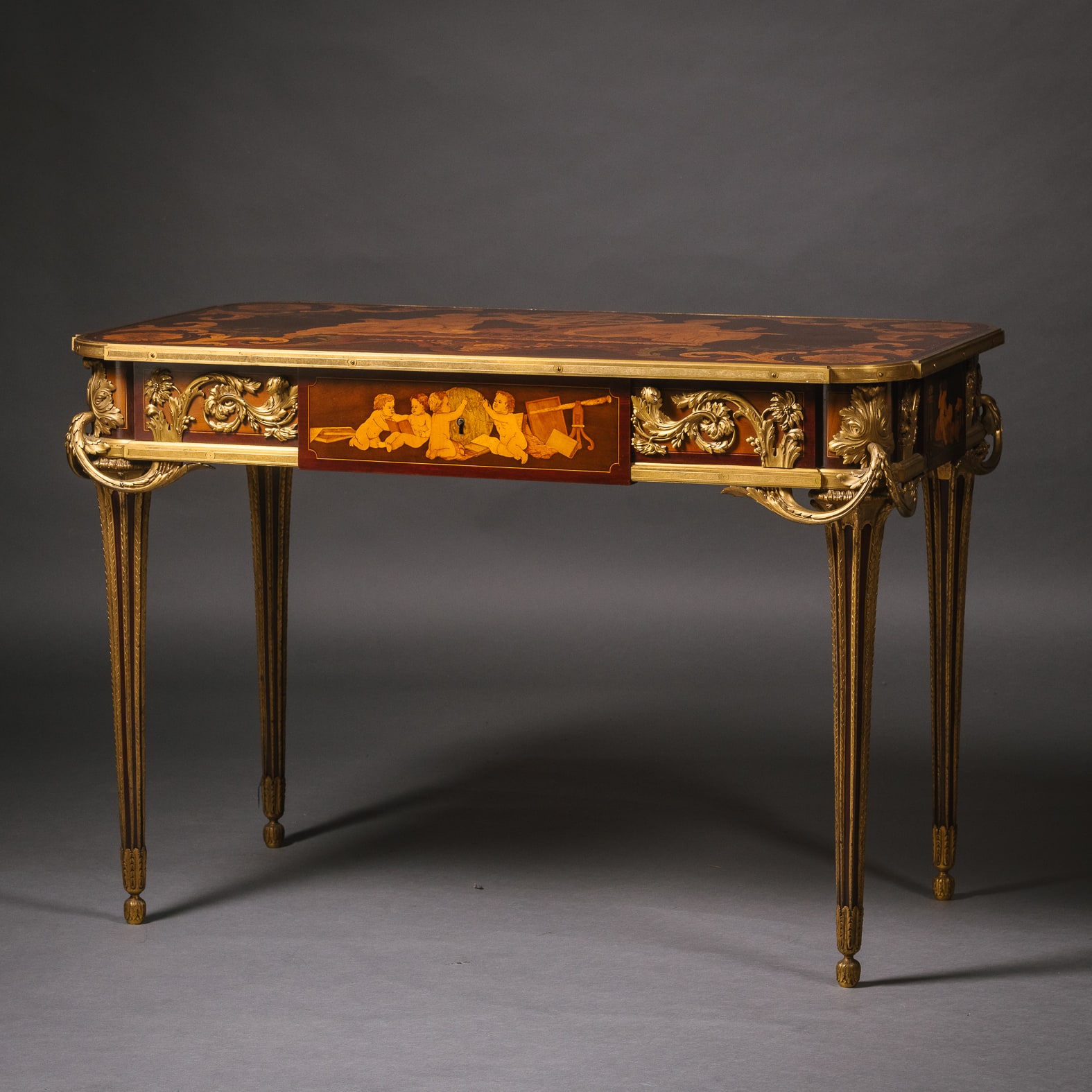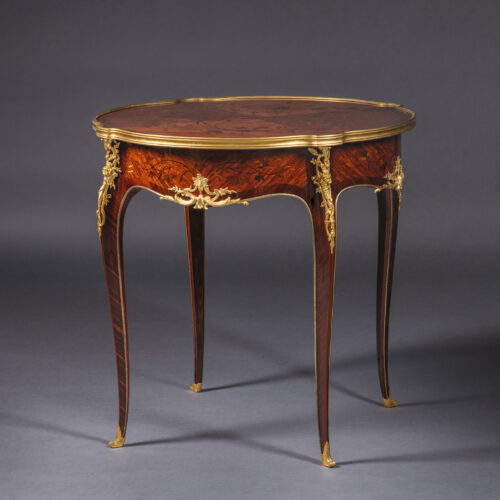Maison Beurdeley
‘Table des Muses’
£55,000
‘Table des Muses’ A Louis XVI Style Gilt-Bronze Mounted Marquetry Centre Table By Emmanuel-Alfred (Dit Alfred II) Beurdeley, After The Model By Jean-Henri...
Dimensions
Height: 75 cm (30 in)Width: 109 cm (43 in)
Depth: 61 cm (25 in)
Description
‘Table des Muses’
A Louis XVI Style Gilt-Bronze Mounted Marquetry Centre Table
By Emmanuel-Alfred (Dit Alfred II) Beurdeley, After The Model By Jean-Henri Riesener.
Stamped ‘A BEURDELEY A PARIS’
The elaborate marquetry top depicts an allegory of Astronomy and Geometry, personified by the Muses Urania and Calliope holding a telescope and a pair of compasses, sitting beside an armillary sphere. The border is richly veneered with paterae and acanthus scrollwork. The frieze has charmingly detailed marquetry panels with putti playing with scientific instruments. The front with a frieze three-quarter draw and quarter secret sprung drawer. The octagonal tapering legs with acanthus cast sabots.
This table by Beurdeley is a superb replica of the famous royal example supplied by Jean-Henri Riesener in 1771 for Louis XVI and now on display at the Petit Trianon at Versailles. At the exhibition of the Union centrale des Beaux-Arts appliqués à l’Industrie in Paris in 1880 Beurdeley fils exhibited about fifteen reproductions of famous works of the eighteenth century including an example of the “Table des Muses”. A table of this model was also shown at the l’Exposition retrospective in 1882 and is visible in a photograph reproduced in C. Mestdagh, op. cit., p. 80 fig. 76. The model of table was reproduced in the late 19th and early 20th century in varying degrees of quality. After Beurdeley, François Linke is the maker of note for this model, but the quality of Beurdeley’s work, especially the marquetry panel is superior.
Date
Circa 1880
Origin
France
Medium
Marquetry and Gilt-Bronze
Signature
Stamped 'A. BEURDELEY A PARIS'

Emmanuel-Alfred (dit Alfred II) Beurdeley (1847-1919)
The Beurdeley family were a flourishing dynasty of three generations of fine quality cabinetmakers working from 1818 to 1895. The firm was particularly well known for its exceptional metalwork, most commonly basing their designs on important eighteenth century examples. Their mercurial gilding and hand chasing are often of such a high standard that it is difficult to distinguish them from late eighteenth century work.
The founder of the dynasty Jean Beurdeley (1772-1853) was a Burgundian craftsman conscripted into the Napoleonic army. After hostilities ended in 1815 he settled in Paris opening a shop for curiosités and working as a latter day marchand mercier. Initially based on the rue Saint-Honoré, in 1840 Beurdeley moved to the famous Hanover Pavilion situated on the corner of rue Louis-Legrand and boulevard des Italiens, and the business was run by his only surviving son, Louis-Auguste-Alfred (1808-1882). This successful business, which had numerous official commissions including in 1853 the marriage coffer for the Empress Eugénie, was continued by Louis’ son, Alfred-Emmanuel-Louis (1847-1919).
The business continued in its traditional style with very few variations until 1895. Alfred, along with the most famous artists of the period, took part in the 1878 Paris Exposition Universelle where he won the gold medal. Following on from this glory, he went on to open a shop in New York.
His participation in the 1883 Amsterdam Universal Exhibition drew even further attention to his work, and possibly as a result he was awarded the Ordre National de la Légion d’Honneur, France’s highest official mark of recognition.
The incredible quality of each generation’s work ranked the firm of Beurdeley as pre-eminent amongst Parisian makers of meubles de luxe.
Bibliography:
Ledoux – Lebard, Denise. Les Ébénistes du XIXe siècle, Les Editions de L’Amateur, (Paris), 1984; pp. 75-82.
Mestdagh, Camille & Lécoules, Pierre. L’Ameublement d’Art Français, 1850-1900, Les Editions de L’Amateur, (Paris), 2010; pp.262-276.
Meyer, Jonathan. Great Exhibitions – London, New York, Paris, Philadelphia, 1851-1900, Antique Collectors’ Club, (Woodbridge, UK), 1984 ; pps. 175, 247, 269, 270, 290, 298.
Acquired by Mr Justin Lecoules in 1939 and by descent to Pierre Lecoules.
This table is illustrated in C. Mestdagh, L’Ameublement d’art français 1850-1900, Les éditions de l’Amateur, Paris, 2010, p. 82 (fig. 78 and 79).














 Print
Print


